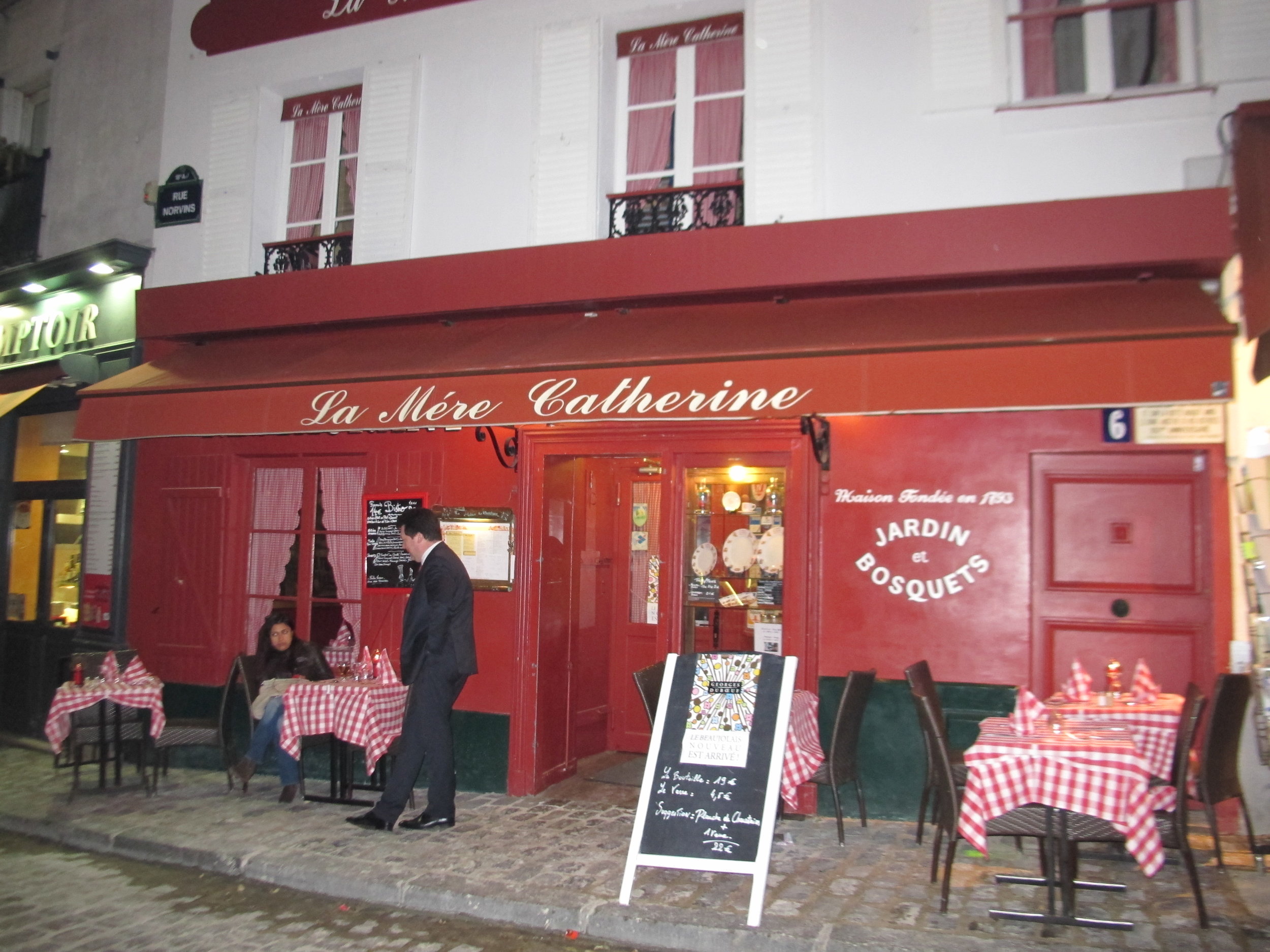There is only one spot left on our June 17-25 Papa’s Paris Tour. But never fear! If this June doesn't work for you, we will have a reprise of our tour September 23-October 1. Find out more on our site or just call me. Reserve by Tuesday, May 30, to get Early Bird Pricing and save $1800! Payment plan available.
Well heeled diners at Le Select, across from La Coupole, Paris. Photo: Elizabeth Kemble.
You’ve been eating all your life, so you think you know all there is to know about dining, right? Well, guess again. Before you set out for France, it’s a good idea to brush up on the finer points of French dining customs.
Le Pot de Fer "Chez Robert," Rue Mouffetard, Paris. Photo: Elizabeth Kemble.
First, there are different kinds of dining establishments in France, ranging from the simple café to the multi-starred restaurant, with brasseries and bistrots in-between. What’s the difference?
Grand Café de la Poste. Photo: Elizabeth Kemble
A café is an informal place where you drop by for a drink, hot or cold, caffeinated or with alcohol, and some light fare. You can stay as long as you like. One caveat: if you go to the bar and order something, you must consume it at the bar – don’t bring it over to a table. The price is lower when ordered at the bar vs. at a table. Note that price differences among cafés can be quite great, depending on the neighborhood and the café’s renown.
Brasserie Zeyer, Paris. Photo: Elizabeth Kemble
A brasserie is also quite informal with good, hearty fare. Brasserie means “brewery,” so brasseries usually have great beer and a fairly standard menu including Alsatian specialties such as sauerkraut with pork meats (choucroute garnie), steak tartare, steak frites, roast chicken, or my favorite, céleri rémoulade, an appetizer of celeriac with a home-made mayonnaise. Their décor typically includes lots of brass and glass.
La Mère Catherine, Montmartre. Photo: Elizabeth Kemble
A bistrot is a small restaurant, usually a mom-and-pop affair, that is open just for certain hours for lunch and dinner, and has a limited menu, usually seasonal. You can find some great home-style cooking at these (it’s not like your Mom’s home cooking unless she was French).
La Closerie des Lilas, Paris. This was Hemingway's favorite café, and now is a brasserie on the terrasse and a restaurant inside. Photo: Elizabeth Kemble.
A restaurant is a fancier affair, usually with longer hours, a professional wait staff, and a star rating. The menu can be either à la carte or prix fixe (they call the latter a “menu” in French, and a menu is a “carte.”) They usually have a pastry chef in addition to a head chef and various sous-chefs. This is where you will get your haute cuisine, or fine dining, characterized by more expensive ingredients, such as foie gras, duck, fancy seafood, perhaps even truffles. It’s great to splurge and go to at least one of these when in France.
It’s best to make reservations for bistrots and restaurants. Most restaurants accept Visa and MasterCard, but not American Express or Discover. Check first! Don't leave home without calling your credit card provider to let them know you will be traveling.
Café Procope, the oldest café in Paris. Photo: Unknown.
Menus are available outside every eating establishment in France, some with English translations, so be sure to check the prices so you won’t have to run home after your meal to get more cash as Ernest Hemingway did when he treated his wife Hadley to a birthday dinner at the high end Café de la Paix. Note that an establishment may have a different menu and price level on their terrasse (outside) compared to inside.
La Closerie des Lilas, terrace menu.
“Entrée” in French literally means “entrance” – when you see it on a menu in France, it means “appetizer.” Main courses are called “Plats,” or may simply be listed after the Entrée and Salade sections as “Pâtes” (pasta), “Viandes” (meat), “Vollailles” (poultry), "Poissons" (fish), or “Fruits de mer” (seafood). If a green salad (salade verte) comes with your meal, it will be served after the main course (plat principal) as a palate cleanser.
Boeuf Bourguignon. Photo: Elizabeth Kemble.
Note that portions are smaller in France than we are used to in the States for several reasons: the French value quality over quantity, they eat multiple courses, so the courses are smaller, and they do like to watch their waistlines, although they may not admit it. Also they don’t like waste. Doggie bags are not available.
Le Bouquet D'Alésia café/restaurant, Paris. Photo: Elizabeth Kemble.
When you are done with your plate, place the utensils parallel to each other diagonally across the plate – this signals the waiter to remove it. A waiter will never ask, “How is everything?”, “Are you still picking?” or “Was it great?” If you need something, signal the waiter. And they will never remove a plate from under your nose while you are still chewing. There is no pressure to “turn tables” and it is expected that you will have a relaxing and leisurely meal.
Chocolate mousse. Photo: Elizabeth Kemble.
Coffee is ordinarily served after the dessert course, so if you want it with your dessert, you will have to specify: “avec le déssert.” You are considered to be in a big rush if you have your coffee with your dessert, but I do it anyway as I like the bitterness of the coffee to offset the sweetness of the dessert.
Au Lapin Agile, Montmartre, Paris. Photo: Elizabeth Kemble.
Wine is one of the great pleasures of the French table. If you are not a connoisseur, I advise asking your waiter to recommend a wine to go with your food. If your dining partners are eating very different types of food, it might be best to get wine by the glass, so you can each get an appropriate wine. The right wine/food pairing can turn your meal from delectable to sublime. Note that the French also always have water with their meals, usually bottled – they take alternate sips of the wine (for flavor) and the water (for thirst). This makes the wine go a lot farther, not to mention one’s sobriety.
Fashionistas leaving a café on the Right Bank, Paris. Photo: Elizabeth Kemble.
Do dress up when dining out, especially in the evening. Your effort will not go unappreciated. Sneakers, t-shirts, athletic wear, baseball caps, and neon colors are not appreciated in a fine establishment, whether a high end café, like Le Select, or a brasserie, bistrot, or restaurant.
Sally reacting to her pastrami sandwich in When Harry Met Sally. Photo: Movies & TV Stack Exchange.
Note that the French usually use “indoor voices,” even when outdoors. Be aware of this in restaurants and match the loudness of the surrounding voices, which is usually a pleasant murmur. Shrieking or screaming with laughter is considered gauche, and don’t yell across a table or tables to someone else. You can signal the waiter (serveur) by catching his or her eye or raising a hand. I still remember a When Harry met Sally moment when a colleague found the patisseries so scrumptious that she couldn’t help expressing her rapture, to the notice of the entire restaurant.
On that note, I hope you find your dining experiences in France every bit as delightful as Sally did her pastrami sandwich.
Richelieu Chocolat, these shoes were made for eating. Photo: Elizabeth Kemble.
So join us in our stroll through the Moveable Feast that is Paris! And for those wanting to range farther afield, join us for a fun and art filled getaway to the beautiful Pyrenees Mountains in Southwestern France from September 17-25. We are working to make this very affordable. Pricing and details will be on our site shortly.
















